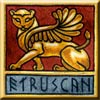
Cels is an Etruscan earth Goddess Who makes the grain grow tall. As is not uncommon among earth Goddesses specifically or Etruscan Deities in general, She has connections with the Underworld and with fate. She is also mentioned as a sun Goddess in some sources; what is clear is that She is the Etruscan forerunner of the Roman grain Goddess Ceres. Her name means "Earth, Ground, or Soil", and comes from an Etruscan root kel- or kil-, "to grow". Related words in Etruscan are cele "large, tall, grown", celthi "augmentation, celebration" and celutule "grown, developed", giving Her name the rough meaning of "The Earth That Causes Growth". She was also known as Cel Ati, "Mother Earth", and She was worshipped at the town named after Her, Celthi, on the northern shores of Lake Trasimene, the modern Lake Trasimeno or Lake Perugia. There is a bronze statue dedicated to Her from Castiglione del Lago, on the western shore of the same lake; whether it came from Her sanctuary at Celthi or from another nearby town is not known. The Etruscan month corresponding to the Roman September was named Celius after Cels as earth and harvest Goddess, and indicates the time of year when the grain is grown or ripe and ready to be cut. Cels also had a role as a Goddess of the Underworld in the interpretation of omens. The Etruscans were famed for their working knowledge of divination and augury, and in taking omens divided the sky into four regions, along a north-south line (called by the Romans the cardo), and an east-west line (the Roman decumanus). The cardo (see also the axis- and hinge- Goddess Cardea) and decumanus were incidentally later inherited into Roman ritual and were the first things marked out when establishing new towns in a proper and auspicious manner. In Etruscan augury, the diviner would stand in a sacred space and imagine himself at the crossing of these imaginary lines. He (or she, as Tanaquil can attest) would then face south and observe in which region of the sky the portents (which could be the flight of birds, lightning strikes, &c) were located. The four main parts of the sky were further subdivided to make sixteen regions in all. Behind the diviner was the region called the pars postica (the "back part"), the section of the sky ruled by the Deities of the Underworld and fate; in front of him/her was the pars antica (the "front part"), where the Gods and Goddesses of the earth and nature made their home. To the diviner's right (the west) was the pars hostilis (the "enemy part", considered unlucky) and to his/her left the pars familiaris (the "friendly part", lucky). The quarters made where the Deity and luck halves overlaid each other had varying degress of auspiciousness: the southwestern quarter was believed to be the most unlucky space, and was called the regiones dirae or "the fearful regions". In this region Cels or Cel Ati ruled over one part of the sky. What that means for Her personality I'm not sure; grain Goddesses are usually considered benevolent, though even Demeter has Her dark side as Underworld Goddess. Perhaps Her position in that section of the sky is meant to indicate that portents from that region are to be interpreted as bad luck for the crops or growing grain. An antefix (a decoration affixed on the roofline of a temple) from Velsna (Latin Volsinii, modern Bolsena), shows two Goddesses who are labelled Mera (Menrfa) and Cilens. Mera is clad in Her usual helmet and breastplate; the figure of Cilens, though missing Her head and left hand, is heavily draped in chiton and himation, much like the typical portrayal of Demeter, the Greek grain Goddess. Cilens or Celens may be a variation of Cels's name; alternately, She may be a seperate deity (having, like Cels, connections to the Underworld) or, as on the Piacenza liver, "Cilens" may even an epithet of Tinia (Jupiter)! Alternate names: Cel, Ati Cel. Also sometimes Apa Cel, or Father Earth, so S/He could go by either gender. She is closely related to the Oscan earth Goddess Kerri. Celsclan, an Etruscan giant identified with Hercules, is Her son. |
|
|



